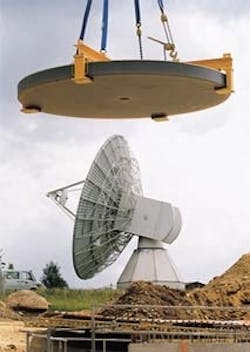Largest ring-laser gyroscope lands in Bavaria
The world's largest (4 x 4 m) ring-laser gyroscope for Earth rotational measurements is currently under construction in an underground laboratory at Wettzell Fundamental Research Station, a geodetic laboratory near Kötzting in the Bavarian Forest mountains of Germany. The DM17 million ($7.75 million) project was commissioned by the German Federal Cartography and Geodesy Office (Frankfurt, Germany.) Startup for the gyroscope, which is being built by Carl Zeiss (Oberkochen, Germany), is scheduled for the summer of 2001.
The centerpiece of the ring-laser gyroscope is a disk of thermally stable Zerodur ceramic glass, 4.25 m in diameter and 25 cm thick, produced and ground by Schott Glas (Mainz). This slab has been placed on a 60-cm-thick granite slab with a weight approaching 10 tons, which is embedded in a monumental concrete table in the laboratory (see photo). Because variations in air pressure and temperature could still have some influence on the volume of the Zerodur disk, it is enclosed in a steel tank for thermal protection of the ring laser and to ensure constant air pressure. A control system eliminates any pressure variations caused by weather conditions.
Ring-laser gyroscopes have long been used in aircraft navigation. This system is intended to increase the sensitivity of the technology more than 1000 times over, permitting precision measurement of irregularities in the Earth's velocity of rotation. These data can help correlate stationary reference systems, in the form of extraterrestrial objects such as quasars or stars, with Earth reference systems. Such measurements are essential for satellite-based navigation systems, including global positioning systems. According to Ulrich Schreiber, technical project manager at the Research Institute for Satellite Geodesy of the Technical University of Munich, these precise rotational measurements could also help geophysicists gain a better insight into Earth's interior structure, including displacements inside the Earth, the continental drift, and earthquakes.
In the ring laser, four highly reflective deflecting mirrors form a closed beam path, which in turn encloses a square surface. When a gas mixture of helium and neon contained in a stainless-steel tube is excited by radio waves, the resonator turns into a laser for two counter-rotating beams. As long as the ring laser does not move, the beams traveling clockwise and counterclockwise display identical frequency. When the ring laser rotates, the frequencies differ by an amount dependent on the speed of rotation of the system.
According to Wolfgang Schlüter, general project manager and director of the Wettzell station, this phenomenon, called the Sagnac effect, can be used to determine the velocity of Earth's rotation. Rotation is relatively slow, though, and the difference in frequency is very small, which translates to a need for extreme measurement accuracy and resolution in the microhertz range—precision only possible with a very large ring laser.
About the Author
Paula Noaker Powell
Senior Editor, Laser Focus World
Paula Noaker Powell was a senior editor for Laser Focus World.
